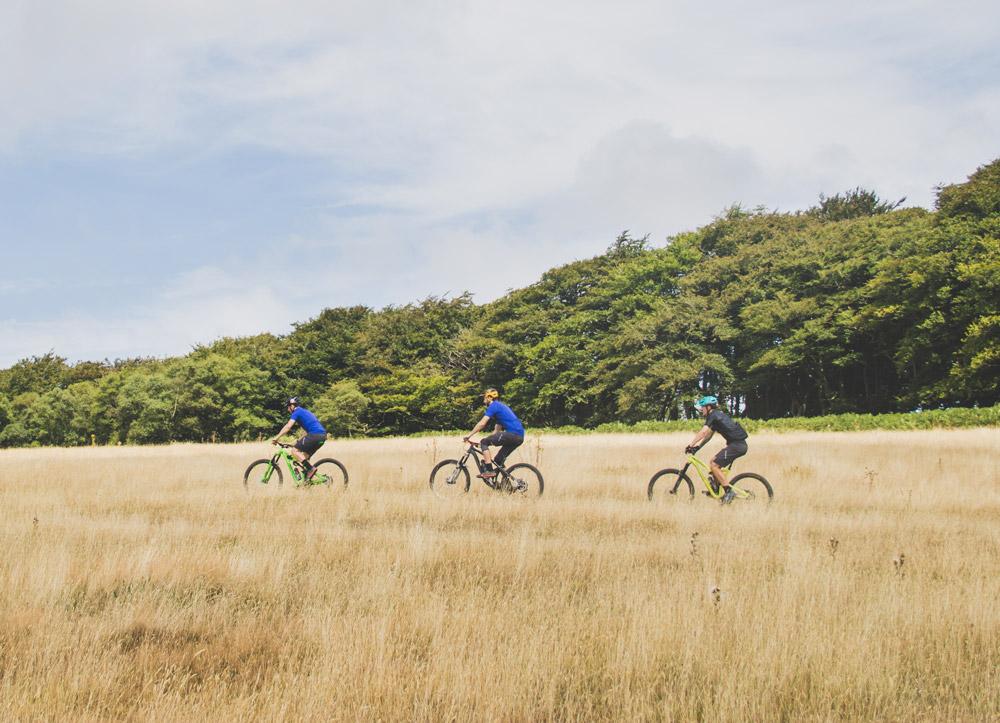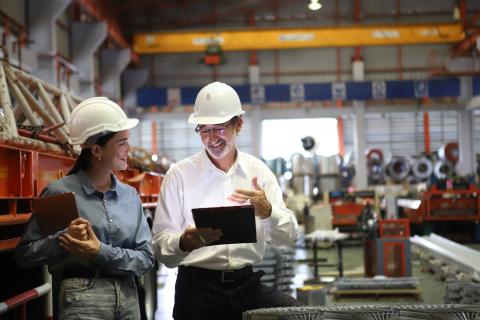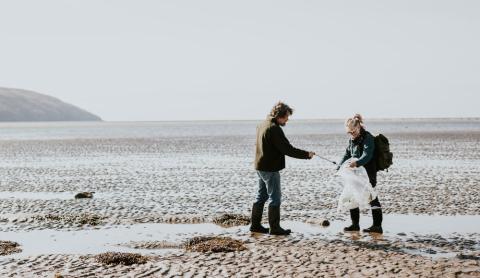Ask the right questions
An important first step is understanding where your workplace is on its journey. Here are five areas that you can explore to understand how you can help your workplace act for nature.
Continue


Five ways to bring nature into your workplace.
Nearly two-thirds (62%) of people surveyed think their employers should be doing more to tackle issues such as nature loss and climate change. (YouGov 2024) But bringing nature into your business can feel like a big task. That's why we've broken it down into 5 areas where you can make a difference.
Once you've picked the area that resonates most with you, these questions are your starting point for the conversation.
They’ll help you explore why your business should care about nature, where you can take action, and what kind of impact you can have.

Having a green pension is one of the best things you can do for nature. Do you know who your provider is, and what kind of investments they are making? Could you make the case for switching to a greener pension plan that helps restore nature?
Are your workplace’s nature and climate plans joined up?
Could your company invest in nature restoration?
How can you leverage your budget to incentivise eco-friendly practices?
Could you consider allocating a portion of your budget to restoring nature or carbon reduction projects?
What land does your company have influence over? Whether it’s the car park verge or a green roof, can you increase the biodiversity in those areas?
Can you get involved with a local green space? Donate tree saplings, plant bulbs?
Can you increase access for nature to your site? E.g. Hedgehog holes in fences
How could you work with and talk to your land managers on how they can increase biodiversity on the site?
What local opportunities are there to help conserve and protect threatened species? This could be looking at setting up species champions, fundraising for local groups or litter picks
Do you know where all your supplies come from?
Can you reduce your environmental impacts by using recycled paper in your office, ensuring plastic free tea bags and reducing meat in the canteen? What does your team buy and how can it change? It doesn’t always mean it’s more expensive!
How can you work with your suppliers to influence their process?
Can you set criteria to your purchasing based on a companies environmental credentials?
Could you analyse factors like transportation emissions, packaging waste, and energy consumption at each stage - from raw materials to finished product delivery?
Who else in your company loves nature? You’ll be amazed at how many of your colleagues care about nature too.
Have you held a Save Our Wild Isles Business film screening? These are free resources ideal for showing your colleagues and peers why they should care about nature.
Have you got a green/eco team you could join?
Can your team do a volunteering day? Could you hold your team meeting outside with a nature theme?
Have you got environmental responsibility embedded into your company culture?
Find out about your company’s nature policy – does your company have one? Has it set Science Based Targets for Nature? Is nature embedded in your net zero strategy?
Ask your CEO or senior management how the company is addressing the nature crisis and remind them it’s a risk to business.
How could you set KPIs for nature in your job? Such as targets for paper use reduction?
Can you use the company's AGM to raise questions or ask for clarification on nature risks and opportunities for the company?
Can you add nature-based reporting to your business’ annual reports?
Case studies

Jade - Self employed
When Jade set up her own marketing firm in Nottingham, running a successful business and protecting the environment was never an 'either or' choice.

After working for a values-driven company that considered the impact of its decisions on customers and the planet, I was inspired to set up a marketing firm that did the same. I run my business to be authentic, tenacious, responsible, and pragmatic. We do things for the right reasons and make sure nature and the environment are considered in everything we do.
When I was writing the content for the company’s website and thinking about why people should work with me or buy my products, it became even more apparent that I should be doing everything I could to reduce the environmental impact of the business.
Saving paper was the first thing I did. Introducing scannable, digital business cards was one of the ways I did this. I then looked at making bigger changes to reduce the company’s carbon footprint.
After getting a subscription for a carbon calculator, I discovered that there were so many more things I could do to protect the environment. Thinking about what you can and can’t change is a good place to start. It was difficult for me to reduce the amount of electricity I was using but amazing to discover I could offset this by changing the way I travel and adopting a remote working policy.
I’ve already made a lot of changes in my personal life to reduce carbon and give back to nature, so it doesn’t feel overwhelming to do the same at work. My husband and I do our bit, including using solar energy, planting a wildflower garden on the driveway, cutting out single-use plastic and easting less meat. I’m also leaving a donation to WWF in my will.
There’s also a lot of help and support out there for individuals, employees, and businesses if you look for it. For example, Nottingham City Council provides all the equipment needed for the litter picking scheme I set up at work. This gives me the chance to give back to the community by volunteering to pick up litter on Fridays.
My long-term aim is to become a B Corp, a company that achieves high standards of social and environmental performance, transparency, and accountability. Carbon footprint measuring is part of it, so we’ve made a good start, but I may have to outsource the work needed to meet all of B Lab’s requirements.
Everything I want to achieve can’t be done overnight but I’m committed to doing as much as I can every day. Every little change makes a difference.
Libby, Lincolnshire Housing Partnership
Libby on how she encouraged her employer to invest more in green spaces
As a sustainability manager for a housing partnership with 12500 homes, and 10,000 green spaces, I believe we can make a real difference for climate and nature.
My work is incredibly varied. I work in several areas, including carbon reduction, educating colleagues, sustainability in the supply chain and supporting biodiversity.
When I started, one focus area was to get the business to see that green spaces can be just as valuable as our built assets. In 2023, we successfully secured over £8m in government funding to install external wall insulation to over 730 homes. Alongside my fantastic colleagues, we started to assess how we could improve the surrounding green space that sits alongside these homes. We were successful in securing funding to plant 180 trees across our neighbourhoods, investing in our green spaces as well as our customers’ homes. To develop sustainable communities, we must look at the wider community, which I believe LHP are placed perfectly for.
We’ve also embedded biodiversity KPIs into our procurement process, which now considers a range of environmental, social and governance issues. This means that all grounds maintenance contracts for green spaces must deliver benefits for nature, people, and wildlife. We now create five new spaces to support biodiversity every year and carry out green audits to ensure nature habitats can thrive. In addition to this, we have also set the ambition for 30% of our green spaces to be managed for wildlife by 2030.
Biodiversity is a mainstream topic of conversation for us now. It’s not possible to secure finance without disclosing environmental, social, and corporate data, otherwise known as ESG reporting. Biodiversity is not just a tick box exercise, it’s a key consideration across our decision-making process.
Considering a wide variety of needs and perspectives has been key to the success of our work on sustainability. Some smaller businesses in our supply chain told us that they didn’t have the time or resources to tackle something as vast as sustainability and biodiversity. To support them I’m issuing guidance on how to achieve net-zero and providing information on the free resources available to SMEs.
I set up a sustainability ambassadors’ group to help interested colleagues improve their knowledge and become sustainability leaders for the organisation. The group meets monthly and hears from external speakers and sustainability experts to ensure that we are continually developing our knowledge as a team.
We also deliver carbon literacy training to help employees understand what we’re doing and why. As part of this training, colleagues can help spark ideas for campaigns and wider engagement events, for example a neighbourhood litter pick. Group activities like this are great for wellbeing and often inspire people to do more for the environment. It can be hard to get people to take that first step to get involved and take time out of their day, but once they do, they never regret it.
Sustainability and biodiversity issues are only going to become more important. The work we’re doing now is an important part of our employees’ personal development and will help future-proof their careers.
When it comes to getting customers on board, it’s important to start conversations about sustainability and nature as early as possible before any work has started on site. It’s about managing expectations. For example, it’s important to explain that an area planted with wildflowers won’t provide colour all year and will have cutting and mowing restrictions. Signs with QR codes are an effective way of providing more information and getting feedback from customers.
If you’re at the beginning of your sustainability journey as a business, take inspiration from what others are doing. Think about what you can learn from them and take those learnings back to your organisation.
Ella, Senior Sustainability Analyst at OVO Energy
Ella has been championing nature positive action at OVO in her role as a sustainability analyst.

I’m a Senior Sustainability Analyst at OVO, and our response to the climate crisis, Plan Zero, has sat at the heart of what we do. We need to ensure that we have a natural world that is protected and can also support reversing the impacts of climate change!
At OVO, we knew it was important for us to address this. Firstly, we set a plan to align to TNFD and by creating a clear and concise case, we got business agreement to become early adopters of TNFD. I am really proud that OVO is just a handful of UK companies that have agreed to do this before it becomes regulatory.
From this we have started to kick off our nature assessment. Using available tools such as ENCORE and the SBTN (Science Based Targets Network) screening tool we have conducted a high-level impact assessment. This will allow us to prioritise areas of materiality and engage relevant stakeholders in the business.
Ana María, R&D Associate, Reckitt
Ana has been using a mixture of educational tools and tangible changes to waste management to reduce her company’s impact on nature.
My background is in academia, in physical chemistry. I discovered my passion for Sustainability when I joined Reckitt three years ago as an R&D Associate working in Air Wick’s Front-End Innovation team. My role was to help design Air Wick’s future air fresheners that would not only meet consumer needs but make them better in terms of their sustainability profile.
Last year, I had the opportunity to take part in a "Skills for the Green Transition" academic programme. It was a very enriching journey that provided a global view of the environmental problems and challenges we face and revealed how environmental sustainability is impacting markets and organisations. This made me even more excited to play an active role in driving green initiatives.
Air Wick and WWF started working together in 2021. Recognising the journey the brand had been on with the ambition to restore biodiversity globally, I was curious to understand whether there was anything that my peers and I, as an R&D community, could do to reduce the environmental impact of our own labs and offices.
This is when we established the Sustainability of R&D Continuous Improvement Team (CIT), as one of the many initiatives across Reckitt aimed at embedding sustainability into the way we work. I also soon became the Air Wick SIC Champion, using Reckitt’s Sustainable Innovation Calculator (SIC) to ensure that upcoming Air Wick launches have a lower environmental impact than current products.
We do rigorous testing during our R&D product/fragrance development to ensure consumer safety and to meet our quality standards. We use many products in our laboratories, which cannot be reused or distributed. We decided to look at this waste stream and see how we could reduce it. Due to the internal electrical components of some of our products we needed a partner that was experienced in the separation of complex materials for recycling. We identified a local waste management company to work with to convert our waste into new items like plastic tables, chairs and plant pots.
Another focus area of the team is using communication and education to spark creative and sustainable thinking. To keep our Air Care colleagues up to date and to inspire them with the latest sustainability launches, we distribute a weekly Sustainability newsletter. In 2023, 49 newsletters were sent containing 308 sustainability-related articles. Finally, we engaged with the community by running a workshop with local school children to explore recycling, the various recycling symbols and local recycling capabilities.
When it comes to waste disposal, we had to understand where the different waste streams ended. Then we had to decide which processes we should focus on, based on feasibility, cost and environmental impact. Finally, we had to look for an external partner that could provide the service.
We worked closely with Reckitt’s Waste Management team to understand the waste disposal process. Finding a local waste management hub very near to our R&D site was key to minimising the emissions generated from shipping the devices to be recycled.
Take the next step.






